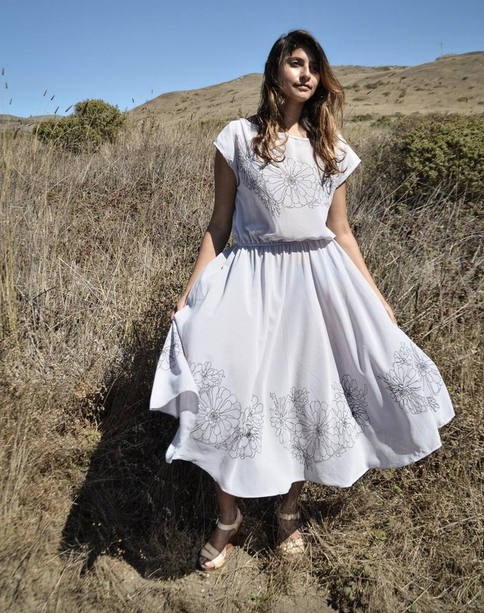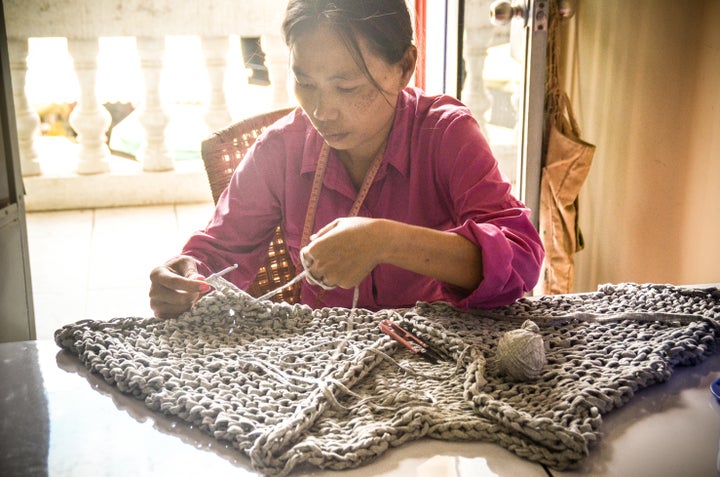This article is part of HuffPost’s “Reclaim” campaign, an ongoing project spotlighting the world’s waste crisis and how we can begin to solve it.
This clothing company is taking others’ trash and turning it into treasure.
Fashion brand Tonlé makes dresses, shirts and pants out of leftover material cast aside by large manufacturers.
The company’s designers get fabrics from the “remnant” markets in Cambodia, where people sell textiles tossed by clothing factories after the cutting and trimming process, Tonlé founder Rachel Faller told The Huffington Post.
Faller’s goal is to fight back against some of the fashion industry’s biggest ills: textile waste and unjust labor practices. Tonlé, which is based in Cambodia and sells its products internationally, employs Cambodian women, pays them a fair wage and allows them to work reasonable hours ― and it makes all its clothing without sending a single scrap to landfills.
“We’re a small company, a drop in the bucket,” Faller acknowledged, “but we can make a statement to the industry that we need to value the materials and the labor that went into them.”
Industry experts estimate that anywhere from 15 to 20 percent of material used to produce clothing ends up “on the cutting room floor” because it’s cheaper to toss than recycle, according to The New York Times. Large manufacturers might deem these scraps unusable because they look damaged or too small.
When companies’ rejected cuttings are dumped in landfills, they decompose and release greenhouse gases, contributing to global warming.
In Cambodia, vendors who sell goods in local remnant markets can make arrangements with a factory to collect its scraps, or they can retrieve discards from factories’ outdoor trash bins.
When Tonlé’s staff go to the markets, they’re searching for fabrics that will be easy to sew together without looking like they come from a bunch of different sources.
“We focus on finding materials there will always be a lot of: cotton jersey, especially in black, grey, navy blue, cream,” said Faller, who previously lived in Cambodia and now oversees Tonlé from San Francisco. “We try to stick to simple colors and fabrics.”

After buying fabrics from the remnant markets, Tonlé staff use the largest pieces to cut into strips and make into garments.
The smaller, leftover strips are handwoven into yarn” and then knit into new fabrics.
Tonlé mixes the tiniest scraps with recycled paper to make its clothing tags.
Founded in 2008, the company has been entirely “zero-waste” since 2014, according to Faller. This means none of the material used to produce its clothing is tossed in the trash.

Tonlé is trying to do something that’s known as “closing the loop.” It’s cutting out waste by making new clothes from existing, recycled or used materials.
Some well-known apparel companies are experimenting with “closed loop” practices, as well. Fast-fashion giant H&M has an in-store collection program, which lets customers bring in previously purchased clothes to be recycled. Similarly, sportswear behemoth Nike says 71 percent of its footwear contains materials made from waste from its manufacturing process.
But these efforts represent relatively small parts of huge companies that, overall, generate significant amounts of trash. Tonlé, by virtue of its small size, has been able to build its business around eliminating waste altogether.
The company also wants to ensure its workers are getting a fair shake.
“My first priority was to hire women in Cambodia, providing good wages and good jobs,” Faller said. “In the garment industry, you have a lot of women working all night and then going home to try to take care of their kids.”
Fashion companies are often called out for questionable labor practices in their sprawling supply chains. For instance, Western companies may source clothing from large factories or mills in developing countries, far from the markets where the finished products will be sold. In Cambodia, it’s not uncommon for garment workers to be overworked and underpaid.
Tonlé aims to buck that trend, employing around 50 people in its small factory. All these workers are local, and most of them are women, said Faller. Many are connected to the company through nonprofits working with disadvantaged women, such as single mothers or women with HIV. Tonlé commits to paying its employees a competitive wage, capping days at 8 hours and offering flexible scheduling.
But prioritizing fair labor and staying zero-waste is a challenge, especially when competing with large chains that sell trendy clothing at rock-bottom prices, says Faller.
Tonlé’s clothing is pricier than some of the garments you might find in a large chain store. The cheapest tops on Tonlé’s website, for example, are priced at $29.
“The fashion industry is really controlled by a few big players, and a lot of those big players have gotten there with unsustainable practices and exploitative employment,” Faller said.
“When you’re trying not to participate in that exploitation, your bottom line just isn’t the same,” she added. “It’s hard to make money when you’re trying to do it in an ethical way.”
More stories like this:
- Here’s What Goodwill Actually Does With Your Donated Clothes
- Why You Should NEVER Throw Old Clothes In The Trash
- We Wore The Same Outfits To Work All Week. Here’s What Happened.
- These African Countries Don’t Want Your Used Clothing Anymore
- This Company Turns Plastic Bottle Trash From The Ocean Into Clothing
- Nearly All My Possessions Fit In A Suitcase, And I’ve Never Been Happier
